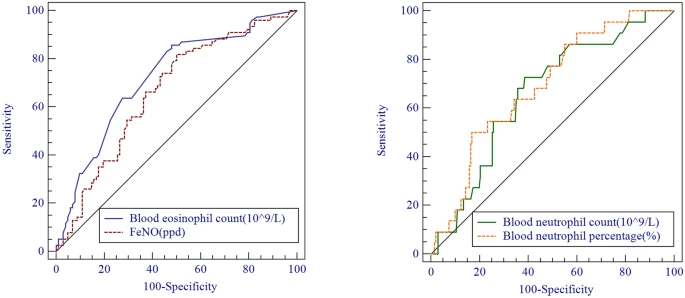Research – Open Access
Bingqing Shi, Wei Li, Yuqiu Hao, Hongna Dong, Wenjing Cao, Jie Guo & Peng Gao
Allergy, Asthma & Clinical Immunology volume 17, Article number: 47 (2021)
Abstract
Background
There is a need to identify the asthma inflammatory phenotypes of patients to facilitate personalized asthma treatment. Sputum induction is time-consuming and requires expert clinical technique. This study aimed to assess the distribution and characteristics of asthma inflammatory phenotypes in Jilin Province, China; it also aimed to identify an easier method for characterization of an asthma phenotype, rather than sputum cellular analysis.
Methods
In this study, 232 asthma patients underwent sputum induction following clinical assessment and blood collection. Inflammatory cell counts in sputum were used to classify asthma inflammatory phenotypes. Receiver operating characteristic curve and Spearman correlation coefficient analyses were used to identify correlations between clinical parameters.
Results

Among the included patients, there had 52.1% paucigranulocytic, 38.4% eosinophilic, 4.3% neutrophilic, and 5.2% mixed granulocytic asthma phenotypes, respectively. In total, 129 (55.6%) patients had asthma-chronic obstructive pulmonary disease (COPD) overlap (ACO); these patients had higher proportion of smokers, higher sputum neutrophil count, worse lung function, and worse asthma control, compared with patients who had asthma alone (p < 0.05). Sputum eosinophil/neutrophil counts were positively correlated with blood eosinophil/neutrophil counts (p < 0.01). To identify the presence of sputum eosinophil proportion ≥ 3%, optimal cut-off values for blood eosinophil count and fractional exhaled nitric oxide (FeNO) were 0.2 × 109/L and 30.25 ppd (area under the curve (AUC) = 0.744; AUC = 0.653, p < 0.001). AUCs did not significantly differ between FeNO and blood eosinophil count (p = 0.162), but both exhibited poor specificity (57% and 49%, respectively). To identify the presence of sputum neutrophil proportion ≥ 61%, the optimal cut-off value for blood neutrophil proportion was 69.3% (AUC = 0.691, p = 0.0003); however, this exhibited poor sensitivity (50%).
Conclusions
Paucigranulocytic asthma was the most common phenotype, followed by eosinophilic asthma. Higher proportion of smokers, poor patient compliance, insufficient treatment, and poor asthma control may have been the main causes of high ACO proportion among patients in this study. Blood eosinophil/neutrophil counts exhibited poor specificity and sensitivity for prediction of airway eosinophilic/neutrophilic inflammation.
